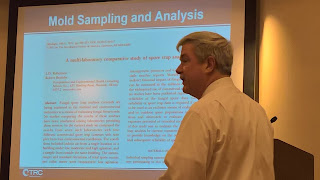- When doing asbestos flooring removal, which method was used the National Institute of Occupational Safety and Health (NIOSH) 7400 Phase Contrast Microscope (PCM) method or AHERA TEM method for clearance? The answers we got was 47.1% used the NIOSH 7400 method; while 29.4% used both methods; and 23.5% only used the TEM method.
- When using the AHERA method for clearance, what was the typical size of the fibers found? The answers we got were 58.8% less than 5 micron; 29.4% both sizes were equal amounts; and 11.8% greater than 5 micron.
- Have you ever encountered during asbestos flooring removal when utilizing both the NIOSH 7400 (PCM) & the AHERA (TEM) methods of analyses, that the NIOSH 7400 passed while the AHERA method failed? The answers we got were 52.6% yes, 36.8% no, and 10.5 never used both.
 |
| Improperly Removed Floor Tiles |
 |
| Another Improper Floor Tile Removal |
Some of the major points from this study were:
- Asbestos used in flooring materials is Grade 7 - Shorts and Floats. The dimensions of this material are very small and may not be resolvable by the Polarized Light Microscope (PLM). Which is why in NYS we require floor tiles to be analyzed as a nonfriable organically bound (NOB) material (analysis by PLM and if negative result for asbestos then analysis by TEM).
- Since the dimensions of these fibers used in the manufacture of floor tiles are so small, it would explain why we typically see very low personal exposure levels by phase contrast microscope (PCM) during floor tile removals. Many ultrafine fibers are not counted due to resolution (0.2-0.25 um) and the count protocol, which provides that only fibers longer than 5 micron with a 3:1 or greater length-to-width ratio are counted.
- Many research studies have found the preponderance of fibers at autopsy left in lung tissue, pleural plaques, and lymph nodes of persons who have occupational exposure to asbestos are shorter them 5 micron in length.
- The NIOSH 7402 TEM method is flawed because it underreports the amount of asbestos in the samples because it ignores all fibers less than or equal to 5 micron and all those fibers longer than 5 micron but less than 0.25 micron in diameter.
- AHERA TEM method counts for total asbestos structures per cubic centimeter averaged 22 times greater than the PCM fiber counts on the same filters.
- AHERA TEM asbestos concentrations obtained during mastic removal with a commercial mastic remover averaged 11 times higher than those measured when removal used amended water.
- The study also found that there was considerable amounts of asbestos dust settled on exposed surfaces during tile removal. Indicating a need to thoroughly HEPA vacuum and wet clean surfaces or dust may remain that could be re-entrained by occupant activity.
- The study also indicates that workers in these areas, would not have to wear respirators, so anyone in these areas would have inhaled asbestos fibers or structures of respirable dimensions.
- The study suggests that for Resilient Flooring Removal clearance sampling should use aggressive methods, require a clearance level of less than 0.005 structures per cubic centimeter for each sample, and all samples analyzed by AHERA TEM protocol. It also suggests a minimum number of samples for clearance should be one sample per 500 square feet, a volume of air of at least 1250 liters, and the use of 0.45 micron mixed cellulose ester filters in a 25 millimeter diameter conducting cassette with a 50 millimeter extension cowl.
We hope this information explains our position, and we look forward to a continuation of this debate. We intend to press the case for a requirement for AHERA TEM clearance for flooring removal, especially if New York State truly intends to move forward with an update of Industrial Code Rule 56.
Related articles





































